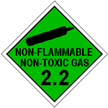| DG sticker symbol |
Group |
Description |
| Class 1 : Explosives |
 |
1.1 |
Explosives with a mass explosion hazard example TNT, dynamite, nitroglycerine. |
 |
1.2 |
Explosives with a severe projection hazard. |
 |
1.3 |
Explosives with a fire, blast or projection hazard but not a mass explosion hazard. |
 |
1.4 |
Minor fire or projection hazard (includes ammunition and most consumer fireworks). |
 |
1.5 |
Blasting agents. |
| |
1.6 |
Extremely insensitive articles. |
| Class 2 : Gases |
 |
2.1 |
Flammable gas – gases which ignite on contact with an ignition source example acetylene, hydrogen. |

 |
2.2 |
Non flammable gases – gases which are neither flammable nor poisonous example oxygen, nitrogen, neon. |
 |
2.3 |
Poisonous gases – gases liable to cause death or serious injury to human health if inhaled example fluorine, chlorine, hydrogen cyanide. |
| Class 3 : Flammable liquids |
 |
3.1 |
Highly flammable liquids with a boiling point below 35 degree Celsius example diethyl ether, carbon disulfide. |
 |
3.2 |
Flammable liquids with a flashpoint of less than 23 degree Celsius and boiling point above 35 degree Celsius example petrol, acetone. |
 |
3.3 |
Liquids with a flashpoint above 23 degree Celsius but not exceeding 61 degree Celsius and a boiling point greater than 35 degree Celsius example kerosene. |
| Class 4 : Flammable solids |
 |
4.1 |
Flammable solids which are easily ignited and readily combustible example nitrocellulose, magnesium, safety or strike-anywhere matches. |
 |
4.2 |
Spontaneously combustible substances example aluminium alkyls, white phosphorus. |
 |
4.3 |
Substances which emit a flammable gas when wet or react violently with water example sodium, calcium, potassium . |
| Class 5 : Oxidizing agents and organic peroxides |
 |
5.1 |
Oxidising agents other than organic peroxides example calcium hypochlorite, ammonium nitrate , hydrogen peroxide. |
 |
5.2 |
Organic peroxides ,either in liquid or solid form example benzoyl peroxides, cumene hydroperoxide. |
| Class 6 : Poisonous toxic and infectious substances |
 |
6.1 |
Poisonous substances which are liable to cause death or serious injury to human health if inhaled, swallowed or by skin absorption example potassium cyanide, mercuric chloride, hydrofluoric acid. |
 |
6.2 |
Biohazardous substances example virus cultures, pathology specimens, used intravenous needles. |
| Class 7 : Radioactive substances |
    |
7
|
Radioactive substances comprise substances or a combination of substances which emit ionizing radiation example uranium, plutonium.
|
| Class 8 : Corrosive substances |
 |
8.1
|
Acids example sulfuric acid, hydrochloric acid . |
 |
8.2 |
Alkalis example potassium hydroxide sodium hydroxide. |
| Class 9 : Miscellaneous dangerous substances |
 |
9 |
Hazardous substances that do not fall into the other categories example asbestos, air-bag inflators, self inflating life rafts, dry ice. |